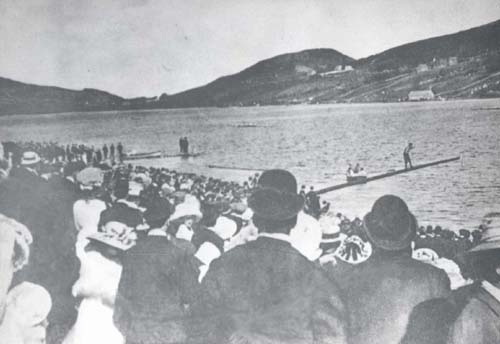Many of the records do not go into detail about exactly what concession stands were held. However, some amusements demanded recognition - making their way into Regatta history.

Advertisement from the 1912 Regatta Souvenir Postcard Booklet
Two of the most amusing attractions of early Regattas were the Greasy Pig and the Greasy Pole. And yes, they are as they sound.
The Greasy Pig
The Greasy Pig was best described in an article from the 1912 Burke's Regatta Programme, taken from an undated Newfoundland Quarterly:
"Though the principal attraction for the lieges in the olden regattas was
to watch the feats of oarsmanship in the spirited and closely contested
races on the days programme, the old timers took other means, some of
them very original and most amusing, to interest the concourse assembled
on the verdant shores of historic Quidi Vidi. For many years a year-old
pig was brought into requisition, and though a humble and certainly useful
animal, especially when converted into ham, bacon, or pork, it afforded great
sport to the patrons of our Derby. The porker was shaved as closely as Mike
Murphy the barber would take the down off the upper lip of a stripling, and
goodness knows, in that state would be hard enough to hold.
"But to add to the difficulty of retaining him, he was carefully greased all over the body and legs. At a given signal he was released, and was the prize of any who could capture him. Squealing as only a pig can, he rushed through the crowds who would try to capture; being no respecter of persons, he would bowl over men, women and children. He was often at liberty for hours, running through the masses of people who hemmed him in on all sides, and sometimes would escape into the lake and go on to the other side and make a break for permanent freedom; or else, being worn out from previous exertions, would find a watery grave - a fate never intended for a self-respecting 'boneen' - in the middle of the pond."
"But to add to the difficulty of retaining him, he was carefully greased all over the body and legs. At a given signal he was released, and was the prize of any who could capture him. Squealing as only a pig can, he rushed through the crowds who would try to capture; being no respecter of persons, he would bowl over men, women and children. He was often at liberty for hours, running through the masses of people who hemmed him in on all sides, and sometimes would escape into the lake and go on to the other side and make a break for permanent freedom; or else, being worn out from previous exertions, would find a watery grave - a fate never intended for a self-respecting 'boneen' - in the middle of the pond."
From Burke's Regatta Programme, 1912
The Newfoundland Quarterly, date unknown
The Newfoundland Quarterly, date unknown
While this sort of amusement would not go over well in 2003, it was certainly a very popular attraction during the early years of the Regatta.
|
The Greasy Pole
Another well known lake-side attraction was the Greasy Pole, which actually endured an evolution of sorts. When it was first introduced in the 1850's, the pole was covered in heavy axle grease and laid out over the water. The goal was for a person to walk the length of the pole, retrieve a prize attached to its end, and return without falling into the water. The prizes attached to the end of the pole could include flour, cash, items of clothing, or food, such as a ham. |

The Greasy Pole (Approximate year: 1900, Source: Regatta Museum).
|
In 1899 a new twist was added to the Greasy Pole. Instead of being laid out over the water, it was erected upright and competitors would have to climb to the top of the pole to retrieve the prizes attached.
This may have been inspired by another climbing game from the 1850's simply called The Climbing Pole. As this pole was not greased, the game was very popular among sailors and fishermen who were used to climbing such heights while at sea.
(continued on Page 2)





